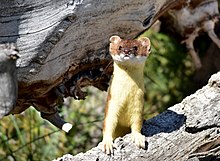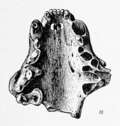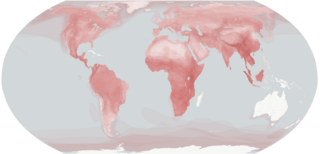
Carnivora is an order of placental mammals that have specialized in primarily eating flesh, whose members are formally referred to as carnivorans. The order Carnivora is the fifth largest order of mammals, comprising at least 279 species.

The Mustelidae are a diverse family of carnivorous mammals, including weasels, badgers, otters, martens, grisons, and wolverines. Otherwise known as mustelids, they form the largest family in the suborder Caniformia of the order Carnivora with about 66 to 70 species in nine subfamilies.

Weasels are mammals of the genus Mustela of the family Mustelidae. The genus Mustela includes the least weasels, polecats, stoats, ferrets, and European mink. Members of this genus are small, active predators, with long and slender bodies and short legs. The family Mustelidae, or mustelids, is often referred to as the "weasel family". In the UK, the term "weasel" usually refers to the smallest species, the least weasel (M. nivalis), the smallest carnivoran species.

Mephitidae is a family of mammals comprising the skunks and stink badgers. They are noted for the great development of their anal scent glands, which they use to deter predators. Skunks were formerly classified as a subfamily of the Mustelidae ; however, in the 1990s, genetic evidence caused skunks to be treated as a separate family. Similarly, the stink badgers had been classified with badgers, but genetic evidence shows they share a more recent common ancestor with skunks, so they are now included in the skunk family. A 2017 study using retroposon markers indicated that they are most closely related to the Ailuridae and Procyonidae.

The long-tailed weasel, also known as the bridled weasel, masked ermine, or big stoat, is a species of mustelid distributed from southern Canada through much of the United States and Mexico, southward through all of Central America and into northern South America. It is distinct from the short-tailed weasel, also known as a "stoat", a close relation in the genus Mustela that originated in Eurasia and crossed into North America some half million years ago; the two species are visually similar, especially the black tail tip.

A marten is a weasel-like mammal in the genus Martes within the subfamily Guloninae, in the family Mustelidae. They have bushy tails and large paws with partially retractile claws. The fur varies from yellowish to dark brown, depending on the species; it is valued by animal trappers for the fur trade. Martens are slender, agile animals, adapted to living in the taiga, which inhabit coniferous and northern deciduous forests across the Northern Hemisphere.

Caniformia is a suborder within the order Carnivora consisting of "dog-like" carnivorans. They include dogs, bears, raccoons, and mustelids. The Pinnipedia are also assigned to this group. The center of diversification for the Caniformia is North America and northern Eurasia. Caniformia stands in contrast to the other suborder of Carnivora, the Feliformia, the center of diversification of which was in Africa and southern Asia.

Meles is a genus of badgers containing four living species known as Eurasian badgers, the Japanese badger, Asian badger, Caucasian badger and European badger. In an older categorization, they were seen as a single species with three subspecies. There are also several extinct members of the genus. They are members of the subfamily Melinae of the weasel family, Mustelidae.

The sea mink is a recently extinct species of mink that lived on the eastern coast of North America around the Gulf of Maine on the New England seaboard. It was most closely related to the American mink, with continuing debate about whether or not the sea mink should be considered a subspecies of the American mink or a species of its own. The main justification for a separate species designation is the size difference between the two minks, but other distinctions have been made, such as its redder fur. The only known remains are bone fragments unearthed in Native American shell middens. Its actual size is speculative, based largely on tooth remains.
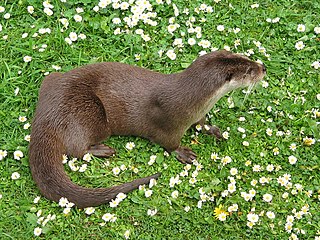
Lutra is a genus of otters, one of seven in the subfamily Lutrinae.
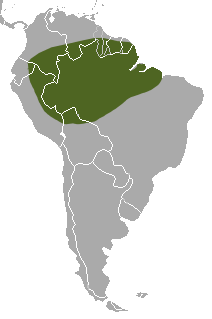
The Amazon weasel, also known as the tropical weasel, is a species of weasel native to South America. It was first identified from a museum specimen mislabelled as coming from Africa, hence the scientific name.

Mustelinae is a subfamily of family Mustelidae, which includes weasels, ferrets, and minks.

Ferret-badgers are the six species of the genus Melogale, which is the only genus of the monotypic mustelid subfamily Helictidinae.

Guloninae is a subfamily of the mammal family Mustelidae distributed across Eurasia and the Americas. It includes martens and the fisher, tayra and wolverine. These genera were formerly included within a paraphyletic definition of the mustelid subfamily Mustelinae.

The Colombian weasel, also known as Don Felipe's weasel, is a very rare species of weasel only known with certainty from the departments of Huila and Cauca in Colombia and nearby northern Ecuador. Both its scientific and alternative common name honours the mammalogist Philip "Don Felipe" Hershkovitz.

Stink badgers or false badgers are the species of the genus Mydaus of the skunk family of carnivorans, the Mephitidae. They resemble the better-known members of the family Mustelidae also termed 'badgers'. There are only two extant species – the Palawan stink badger or pantot, and the Sunda stink badger or teledu. They live west of the Wallace Line; the Sunda species on islands of the Greater Sunda Islands, being Sumatra, Java, and Borneo; in Borneo the badger is found in Indonesia, Malaysia and Brunei. The Palawan species lives in the Philippine island of Palawan as well as the islands surrounding it.

Arctoidea is a clade of mostly carnivorous mammals which include the extinct Hemicyonidae (dog-bears), and the extant Musteloidea, Pinnipedia, and Ursidae (bears), found in all continents from the Eocene, 46 million years ago, to the present. The oldest group of the clade is the bears, as their CMAH gene is still intact. The gene became non-functional in the common ancestor of the Mustelida. Arctoids are caniforms, along with dogs (canids) and extinct bear dogs (Amphicyonidae). The earliest caniforms were superficially similar to martens, which are tree-dwelling mustelids. Together with feliforms, caniforms compose the order Carnivora; sometimes Arctoidea can be considered a separate suborder from Caniformia and a sister taxon to Feliformia.

Pekania is a genus of mustelid that contains a single living species, the fisher (Pekania pennanti). Formerly placed in the genus Martes, it was determined to be distinct enough to be placed within its own genus. A 2013 study also identified several fossil species formerly in Martes that are more closely related – and probably ancestral – to the fisher, moving them into Pekania as well.

Ictonychinae is a subfamily of the mammal family Mustelidae found mainly in the Neotropics and Africa, with one Eurasian member. It includes the grisons, Patagonian weasel, striped polecats, African striped weasel, and marbled polecat. These genera were formerly included within a paraphyletic definition of the mustelid subfamily Mustelinae.
